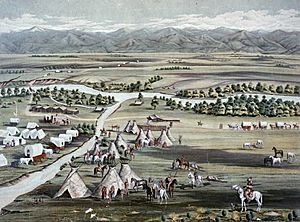Little Owl (Arapaho chief) facts for kids
Little Owl (Arapaho: Beah-at-sah-ah-tch-che) was an important leader, also known as a chief, of the Northern Arapaho people. He was famous for signing the Treaty of Fort Laramie (1851). However, he was very upset because the United States government did not keep its promises from that treaty. Because of this, Little Owl refused to take part in signing the later Fort Wise Treaty.
Contents
Life of a Northern Arapaho Chief
Little Owl was the chief of a group within the Northern Arapaho people called the Long Legs band. His relative, Sherman Sage, who became an elder later, shared stories about their family's life. Arapaho people often lived in family groups, usually with sisters living together.
There were generally four main groups, or bands, of Northern Arapaho. These were the Beavers, Greasy Faces, Quick-to-anger, and the Long Legs (also called Antelopes). They lived by hunting animals and gathering plants, moving together through different seasons. They would meet with other groups for big hunts and special ceremonies, like the Sun Dance.
Each band had its own chief. There was also a head chief for all the Northern Arapaho, who was usually from the Long Legs band. The head chief talked with leaders from other Native American tribes and with white people. This head chief had great influence over everyone. Their decisions were always wise and proper, and the people followed them like laws. Little Owl became the head chief after Bear Claw. Medicine Man later became the head chief after Little Owl.
Signing the Fort Laramie Treaty of 1851
Little Owl was a friendly chief in his middle age. He was chosen to be the Arapaho head chief to sign the Treaty of Fort Laramie (1851). From the Southern Arapaho, chiefs named Cute Nose and Big Man also attended.
An elder named Autho-nishah told Little Owl and the other signers to promise to honor the treaty's rules. He reminded them that "the Great Spirit is over us, and sees us all." White people who knew Little Owl respected him. During the talks, Little Owl and other Arapaho leaders spoke in a calm and friendly way. This was different from the Sioux, who made "begging speeches."
Little Owl wore a special uniform of a high-ranking officer. This uniform was a gift from the United States government. It showed that he was a powerful Arapaho leader. Big Man and Little Owl signed the changed treaty for the Arapaho on August 31, 1853. After signing this treaty, the Northern Arapaho became a tribe officially recognized by the United States government.
Broken Promises and Changing Times

After 1851, Friday started working as an interpreter for Little Owl. Little Owl's band had about 180 lodges (homes). They visited the surveying group of Ferdinand V. Hayden and Captain William F. Raynolds around 1859-1860.
The Arapaho people often camped where Cherry Creek meets the South Platte River. But during the Pike's Peak Gold Rush, many miners settled in this area. This place later became the city of Denver. The Arapahos tried to live peacefully with the white settlers.
However, in the 1850s, the United States government started breaking its treaty agreements. This made the friendly chiefs, like Little Owl, who had signed the 1851 treaty, lose some of their good reputation. Warriors, who were known for fighting, became more respected.
Because of the broken promises, a new leader named Medicine Man was chosen to speak for the Arapaho at a treaty meeting in 1859. Other important leaders there included Little Owl, Black Bear, Friday, and Cut Nose.
Refusal of the Fort Wise Treaty
Little Owl refused to be part of signing or recognizing the Treaty of Fort Wise (1861). Some Arapaho groups in Colorado were ready to live on a reservation at Sand Creek. But Little Owl and Friday wanted to keep living along the Cache la Poudre River in northern Colorado.
In 1863, when the reservation was set up, Little Owl was still against moving his band of about 50 lodges to Sand Creek. There was no game (animals to hunt) on the reservation land. Buffalo, a main food source, were 100 or more miles away. At this time, there were also disagreements between the Northern and Southern Arapaho people. Starvation became a big problem. People worried that the Southern Arapaho might join the Sioux in a war against the white settlers.
On November 29, 1864, during the Sand Creek massacre, white soldiers attacked an Arapaho and Cheyenne camp without warning. After this terrible event, Arapaho chiefs became known as "war chiefs" because of their fights against the white settlers in Colorado, Wyoming, and Kansas.
Popular Culture
Little Owl is mentioned in a book about important Native American chiefs and leaders.


